
Chapter 19
Could Noah’s Ark Have Been Made of Wood?
There’s a biblical ark that rode out the Flood, and it was no bathtub. Noah built it somehow, with or without some mysterious ancient technology or extreme gopherwood. Does this mean God had to suspend the laws of physics to keep Noah afloat?
Let’s say He didn’t. In that case, could Noah get through the whole ark operation?
Building the Ark
Constructing an ark of biblical proportions would take time, resources, and know-how.
Time: Noah had plenty of time — 120 years in fact. In Genesis 6:3, the Lord said, “My Spirit shall not strive with man forever, for he is indeed flesh; yet his days shall be one hundred and twenty years.” Some take this as God setting the human lifespan to 120 years. There’s a problem with that: every patriarch from Noah to Amram broke God’s new “ruling.” Noah made it to 950 years of age, his son Shem was 600, and even Abraham died “full of years” at 175.
It’s not about lifespans, but about God giving Noah 120 years warning of the Deluge. That’s a long time to build a boat—too long, in fact. At that pace, Noah would still be chipping away at the stern while the bow had been exposed to the weather for a century. It makes more sense that Noah spent a lot of this time in preparation until, with everything prepared, he organized a serious barn-raising.
This is where the pitch comes in. The pitch for Noah’s ark was probably not bitumen but the gum-based resins extracted from certain trees (such as pitch pine). Wooden ships were routinely waterproofed in this way. The difference here is that God directed Noah to apply the icky goo inside as well as out. That’s a lot of pitch, so no doubt God had a good reason. Here are two: pitch stabilizes the moisture content of the wood and acts as a preservative. This is ideal for a larger-than-average wooden ship that takes a decade or more to assemble, not just the typical year or so.
Resources: Did Noah need help? A pit-sawing team (of two) would take many decades to cut the wood for one ark. That’s cutting it close. Noah and sons had other things to focus on, so it makes sense that labor was hired, or that processed materials like sawn lumber were purchased. Noah should have been extremely wealthy having lived 480 years before the project even began. He probably had the help of his grandfather Methuselah,1 who lived to see the ark constructed.
His world had abundant resources (particularly timber and food), and bronze and steel technology had been around for generations ever since Tubal-Cain first got into working bronze and iron (Genesis 4:22). With such long life spans, technology could rapidly increase in the 1,656 years from Adam to the Flood.
But let’s not get too carried away. There are limits to the technology of the pre-Flood world. The ark was made of wood, not metal, which is better for ship hulls. There were also no other survivors in ships (or space-stations for that matter!). The civilizations immediately after the Babel dispersion give us some clues. They excelled at building big things in difficult materials but were not industrialized in the modern sense. An appropriate estimate for the level of technology in Noah’s day might be something on par with ancient Egyptians, Greeks, Romans, Chinese, etc. The Egyptians could drill and cut granite; the Greeks could build huge ships with furniture-like precision. These were very ingenious, accomplished builders, experts in crafting metals, ceramics, and other materials — but without the industrialized manufacturing made possible with electricity and heat engines (i.e., steam or combustion engines) implying high-precision machine tools.
We will treat such industrialization as missing from the pre-Flood world as we describe the following construction materials and techniques.
Permitted materials and hardware: (Technology of ancient civilizations) Wood: Accurately sawn to fixed sectional dimensions. An up/down saw driven by flowing water or animal draft power, for instance. Sawing is a key technology. Metals: bronze and iron (cast and/or hand forged). Ceramics: fired and glazed pots, oil lamps, stoneware, small glass panes. Other: leather, bone, animal, and resin glues. Fasteners: wooden pegs, metal rods, spikes, and straps. Basic processing/cooking/distilling of pitch/glues. Hand tools in bronze and iron: Drilling auger or spade bit, hand saws, axes, chisels. Measurement: basic surveying, water levels. Lifting and carrying devices: cranes, winches, wheels, rollers, rope, and pulleys. Special long lead-time methods: Planting and harvesting old-growth trees, training trees into shapes (arborsculpture), breeding and training of animals.
Excluded materials and hardware: (Technology after the Industrial Revolution) Electrical power machines, heat engines (steam or internal combustion), threaded bolts and screws, rolled steel plate, metallic films and sheet, processed polymers, highly oxidizing metals like aluminum and titanium, stainless steel, electronics, advanced chemical processing, engineered wood products such as finger jointed and glulam beams, bulk dressed lumber (planed), plate glass (laminated or tempered), steel rope and drawn steel wire, advanced adhesives like epoxy.
Know-how: There are many examples in Scripture where God called people to tackle things outside their expertise, so Noah may not have had much experience in shipbuilding. This is rather unlikely at age 480, but on a 120-year project he could afford to do decades of research.
Having lived for around five centuries, Noah may have been perfectly capable of designing the ark all on his own. The ark is briefly specified in only three verses (Genesis 6:14–16), even lacking crucial data such as the number of animals or amount of food. Perhaps Noah was given more detail, just like Moses received the tabernacle instructions that included exact dimensions and even the number of curtain rings. There’s a hint given in Genesis 6:22: “Noah did everything just as God commanded him” (NIV), which strongly parallels Exodus 39:32: “The Israelites did everything just as the Lord commanded Moses” (NIV). Perhaps this “everything” was more than three verses we have recorded for our benefit, or maybe this is all he had to go on.
Either way, Noah had to get it right the first time — there were no second chances. As far as miracles are concerned, there is one “miracle” recorded; God gave instructions, however brief.
Launching the Ark
The launch of the ark was not meant to be an extreme sport. Noah needed a safe way to launch during earthquakes and strong currents.
The Flood started suddenly when “on that day, all the fountains of the great deep were broken up, and the windows of heaven were opened” (Genesis 7:11). Any flood that rapidly inundates the world (in 40 days or less) will involve massive high-speed currents that would dwarf any modern tsunami. In fact, no modern flood lays down sediments anything like the huge, fossil-filled rock layers deposited all over the world. Such a sudden inundation would pulverize everything in its path, including all shipping and coastal settlements.
How could the ark survive? One solution is to launch from the highest point. This keeps Noah out of the violence of the initial inflows of ocean water as predicted by the Catastrophic Plate Tectonics model.2 The Flood went on to drown every mountain in the pre-Flood world (Genesis 7:19). Since modern oceans contain enough water to drown the planet to a depth of about 1.8 miles (2.85 km),3 the pre-Flood terrain was probably limited to within this elevation.4 By the time the water reached the ark, the currents would have slowed to manageable levels before the launch.
Noah, whether by acumen or divine guidance, may have selected an elevated site where temperate conditions could support a pine forest. Pine, a possible candidate for the mysterious “gopherwood,” is especially suited to both shipbuilding and pitch production. This original location is unknown to us today because “the ark moved about” (Genesis 7:18) before finally coming to rest in the Middle East. Gopherwood doesn’t have to be a desert acacia, or even a cedar of Lebanon. The very fact that gopherwood is never mentioned again suggests the wood had vanished too. It may have been alive and well on the other side of the world, be it Douglas fir, yellow pine, or even teak.
Here is a quick rundown of a possible construction plan.

Figure 1. (A). The ark constructed at a high elevation (by pre-Flood standards). (B). Violent inundation devastates lowlands. (C). Water surface less severe once oceans meet.
Noah clear-cuts the hilltop expanse. A foundation is prepared with massive stone walls running transversely to support the hull. Large stones give resistance to strong currents, and tapered ends avoid snagging. Besides all that, don’t ancient people always seem to baffle us with their stonework — oversized and outrageously precise? Those ancient civilizations were not a great many generations after Noah himself (Genesis 10).

Figure 2. the ark built on pedestal walls to provide underside access and a safe launch.
The three keels laid on the foundation walls help to:
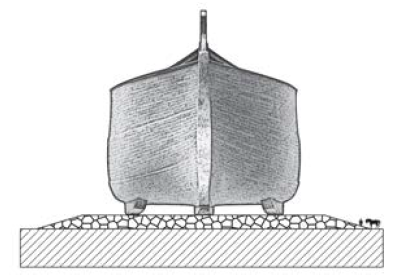
Fig. 3. Ark built on pedestal walls: very heavy stonework to resist erosion during launch.
- form a base to erect frames while the bottom can still be planked from underneath;
- hold the hull upright without shoring (handy when planking multiple layers);
- absorb earth tremors and turbulent water (sliding at wall/keel interface);
- reduce rocking in waves (increased roll damping);
- improve direction-keeping in winds (keel gets deeper toward the stern);
- resist abrasion (multiple sacrificial layers — false keel/keel shoes);
- keep the ark level when beached (sloping floors would be annoying for seven months!).
These massive keels are built up by laying beams and pinning them together (edge bolted). The lower members within the keels are not scarfed in order to manage stresses.5
Ships are normally launched on a slipway, but in Noah’s case “the waters increased and lifted up the ark” (Genesis 7:17). Extra safeguards would be prudent, such as releasable mooring ropes to keep the ark from moving away until properly buoyed. There should be no solid obstacles higher than the skid platform — including tree stumps.
The Ark on the Floodwaters
Once afloat, the depth of the water would average almost two miles (three km),6 shielding the ark from tectonic activity. Deep water is safe in a tsunami.7 The ark had to survive the ocean surface, not the massive sediment flows at the seabed.
But the surface was no picnic either. Later in the voyage, God sent a wind (Genesis 8:1), and wind creates waves, so rough seas are at least part of the five month voyage. Since the proportions of the ark (Genesis 6:15) are ideal8 for an ocean-going vessel, it was obviously meant to behave like a ship. With such proportions, the necessary stability and sea kindliness can be achieved even for extreme seas,9 by a suitable coordination of hull shape and load distribution.
But is it even possible for a wooden vessel as large as Noah’s ark to survive the stresses at sea?
The Trouble with Carvel Hulls
The largest wooden ships in recent history (1800s and early 1900s) tended to flex in rough seas, making them prone to leakage. These ships were carvel-built, a plank-on-frame construction method that lacks inherent resistance to racking.10 The stiffness of the hull depended almost entirely on the tightness of caulking between planks.

Figure 4. racking: without bracing, a plank-on-frame structure distorts to a parallelogram under shear loading.
Carvel11 planking dominated wooden shipbuilding in the last few centuries. The method was simple and quick, but a new ship did not stay a “tight ship” for very long. Even fitting two pins in each plank gave little improvement.12 Larger ships were subject to higher forces, accelerating the loosening of the caulked planks. This led to reinforcement with iron straps.
These diagonal straps certainly helped improve a bad design and gave the single layer of carvel planking some much-needed shear resistance. But the steel straps were pinned (bolted) to softer wooden frames, a considerable stress concentration, especially at the ends of the straps.
This led to the next patch-up — steel plates at the top and bottom to secure the diagonal bracing. That kept the hull sides intact, but now the problem was transmitted to extremities, like the top deck.13
Later, during World War I, steel was scarce and wooden supply ships14 were being built in a hurry. Naval architects revisiting the carvel hull-bending problem made big increases to keelson depth15 and upper deck reinforcement (using clamp and shelf strakes).16 One design aimed to “produce a boat which will have strength equivalent to that of a steel hull without using excessive amounts of timber.”17 It had a double layer of diagonal planking under the standard planks. That is not a carvel hull; it is cold-molded just like the wooden minesweepers built in the 1990s.18
So the shortcomings of a carvel hull are not easily corrected.19 A better way is to use a planking system with inherent shear strength, akin to a house frame braced with plywood instead of clapboards (lap siding or weatherboards).
The claim that Noah’s ark is an impossible size for a wooden ship is based on the apparent limiting size of documented wooden ships of the 1800–1900s; around 330 feet (100 m) even with iron bracing. In comparison, using one of the most reliable ancient cubits, the Royal Egyptian Cubit at 20.6 inches (0.523 m), Noah’s ark would be 515 feet long, 86 feet wide, and 51.5 feet high (157 m x 26 m x 15.7 m).
That makes it about 50 percent longer than the longest wooden ships in modern records.
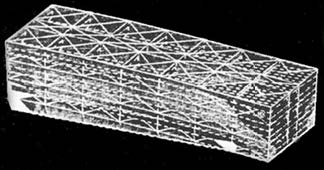
Figure 5. Lattice of 2 feet (0.5m) square beams. The ark may well have been constructed by joint structures of frames and plates. The frame structure of thick beams (50 cm x 50 cm) could have been installed in longitudinal, transverse, and diagonal directions, and connected to each other at each end. The plate structure may have been attached to the frame structure to make the shell, deck, and compartments using thick boards (30cm).
Working with Wood
Is this proof positive that the laws of physics must be suspended to keep Noah afloat? This assumes that Noah’s ark is built like a carvel hull, or worse. Wood may be an ancient building material, but it still has a competitive strength-to-weight ratio, even compared to metals. For large structures like buildings, bridges, and ships, the problem is not the strength properties of the wood itself, but the manner of joining.20
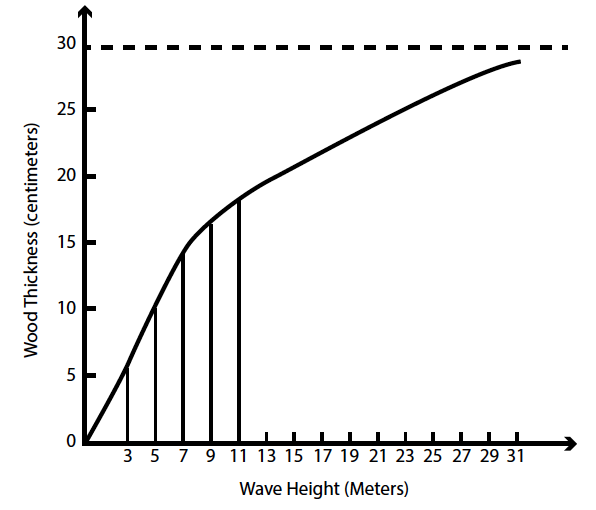
Figure 6. Plate structure (planking) thickness vs. wave height. To calculate the voyage limit from the structure viewpoint, the required thickness of the wood was plotted for varying wave heights. This showed that the ark’s voyage limit was more than 30 meters if the thickness of the wood was 30 cm, which was quite a reasonable assumption.
Using the strength properties of wood, calculations can determine the required thickness for a vessel the size of Noah’s ark operating in extreme seas. Naval architects at the world-class ship research center KRISO (renamed MOERI in 2005) in Korea, studied Noah’s ark in 1992 and declared the biblical specifications sound. They used a planking layer 12 inches (0.3 m) thick, taken as a shear resistant “plate structure.” Internal structural framework comprised of beams 20 inches (0.5 m) square.
This structure was assessed to determine the stresses on the hull under increasingly severe ocean conditions, with irregular (random) waves up to 30 meters (98 feet).

Figure 7. Diagonal planking
Planking
There are several ways to create this integrated “plate structure.” Carvel is not one of them:
- Diagonal planking. The definitive way to build a strong wooden hull is to use multiple diagonal layers. Used for U.S. Navy minesweepers (1990s) and PT boats (1940s), diagonal planking also appeared in the design of World War I wooden steamers.21 However, the British beat them to it with multi-layered diagonal planking in Aberdeen ships such as Vision22 (1854), Schomberg23 (1855), and Chaa-Sze24 (1860), and even “Queen Victoria’s new yacht.” In 1998, another old ship, the USS Constellation, was switched from carvel to diagonal planking to avoid clumsy steel beams to fix hogging strains.25 In 2012, naval architects proposed a wooden hull laminated in diagonal layers for the 463 feet (141 meters) yacht Dream Symphony.26
- Mortise and tenon planking A spectacular (almost unbelievable) solution to shearing between planks includes mortise and tenon attachments. Characteristic of Greek and Roman ships, this method was in use well before the 14th century before Christ,27 then faded away around A.D. 500 to be forgotten until recently rediscovered through underwater archaeology. This lends credence to the records of arksized wooden ships of antiquity. For example, Athenaeus discussed a large warship that was 427 feet (130 m) long. It was built by Ptolemy Philopater around 250–200 B.C.28 It proved itself worthy, even in war. Then there was the Leontifera — based on the specification of 8 tiers of oarsmen, it is estimated at about 393 feet (120 m) long.29
- Multiple layers of planking. Simple but effective. This method was clearly used by Chinese shipbuilders,30 which would include the treasure ships of Zheng He (a.d. 1400s), with a reported length of 444 chi (137m or 450 feet). It was also seen in Greek and Roman ships (80s B.C.).31 More recently (A.D. 1800s) multiple layers were employed for impact with floating ice.32 Each successive layer of overlapping planking dramatically increases the shear resistance of the planking system. Even a double layer is “vastly superior to single carvel.”33
- Edge bolted. The easy way to do mortise and tenon is to use vertical pins (drift bolts) to connect horizontal members (strakes) together. By the sixth century A.D., iron spikes had replaced the painstaking mortise and tenon for edge joining of planks.34 This technique was used by American shipbuilders35 to fasten ceiling strakes and keelsons together.36
- Chocks or keys. Low-cost edge joining best suited to inner layers of planking and ceiling strakes was also employed to keep the planks from shifting. Frame chocks were also used. A system of plank interlocking was patented by Heber Squiers in 1876.37
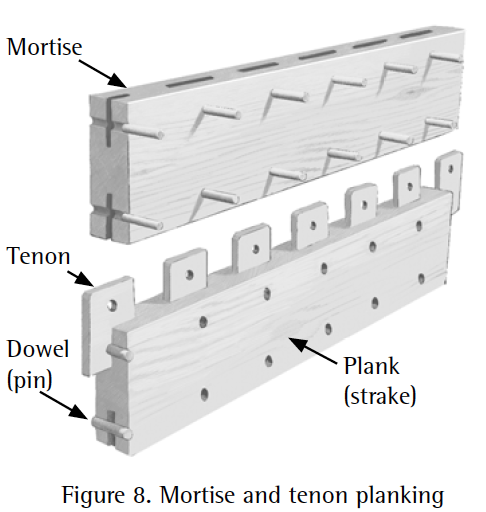
Figure 8. Mortise and tenon planking
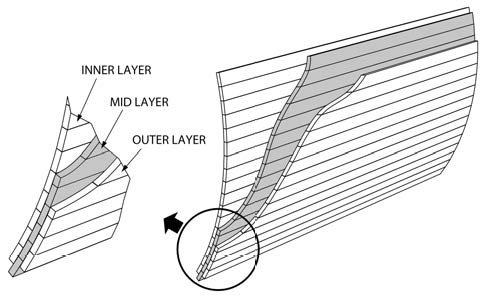
Figure 9. Multi-layered planking
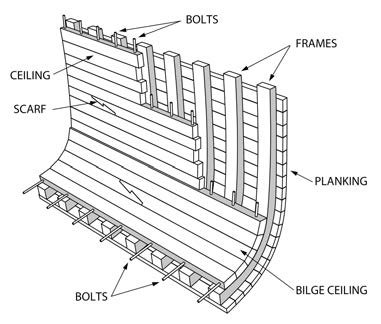
Figure 10. Edge-bolted planking
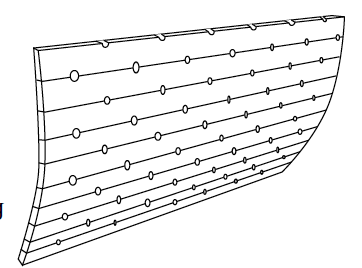
Figure 11. Edge-keyed planking
Internal Framing
The Hong study (see footnote 8) also included frames and beam members (50 cm x 50 cm) in their structural analysis. These beams need to be joined together somehow, a critical detail especially in joints that could undergo completely reversed loading. Due to the wave loadings and accelerations at sea, joints that normally sustain compression forces can also go into tension. These joints are the most difficult to achieve in wood, but the full tensile strength of a 0.5 m square beam is an unlikely requirement. Joints must be designed to handle various combinations of compression, tension, twisting (torsion), and possibly bending.
There are a number of structural options for joining large beams. All are held together by metal rods (called bolts) driven into pre-drilled holes, or spikes (large nails). Metal fasteners are also found in large ancient ships.
- Knees. A knee is a reinforcing elbow made from a natural bend, typically in large oak branches (crooks). A hanging knee, based on American clippers, used iron “bolts” driven through and clenched.
- Clamps and Shelves. A shelf was reinforced with thick longitudinal beams (shelf/clamp) bolted through both frames and beams. Detail based on WWI wooden motor ship.
- Straps. A cast or hand-forged bronze strap was held by spikes to opposing members to take tensile forces. Iron straps (or stirrups) were typically used to reinforce connections where axial forces dominate (such as stanchion to deck beam). Straps can also accommodate complex members like diagonal braces.
- Lamination. A shear wall performs the dual role of bracing the frame and tying framing members together. This is also the most effective form of bracing.
Each of these framing joints has its own merits and is suitable for different tasks, so several of these methods can be found on any one ship.38
The familiar mortise and tenon framing joint is conspicuously absent in primary ship structures. It is too weak, especially in tension.

Figure 12. Knee type framing joint
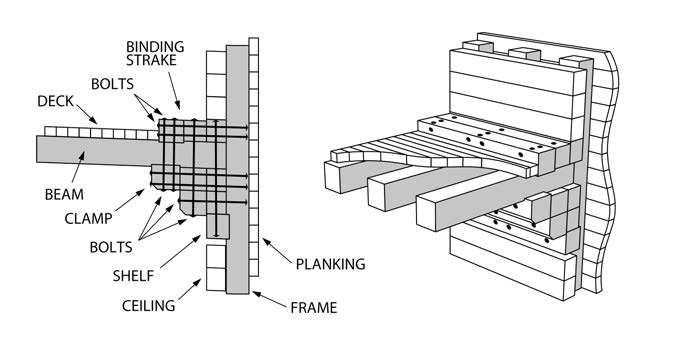
Figure 13. Clamp type framing joint
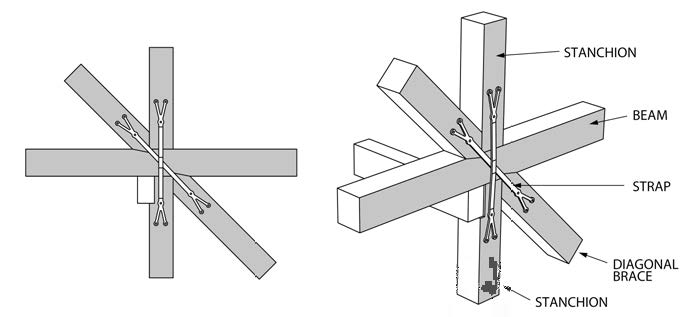
Figure 14. Strap type framing joint
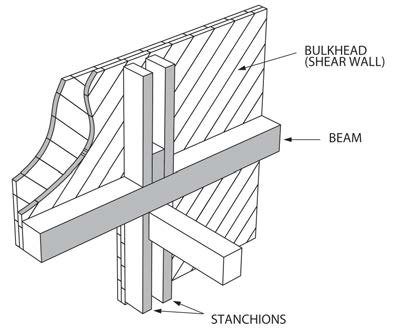
Figure 15. Bulkhead type framing joint
Bulkheads
Another problem for these “oversized” carvel ships was weak frames39 or “ribs.” The curved frame profiles were built up of many short segments bolted together, but this made them flex and go out of shape. Modern wooden frames are laminated, but the best fix is to use bulkheads — lateral shear walls at regular intervals along the hull. The Chinese were doing that at least 12 centuries40 before Benjamin Franklin suggested it in 1787.
Extensive use of internal walls actually suits the ark. It was never meant to have a cavernous interior; in fact, quite the opposite. Noah was directed to build “nests” for the animals, not cattle yards. Private enclosures are appropriate for the transport and care of live animals as it helps to keep them calm. From a structural viewpoint, this could mean plenty of bulkhead structures (walls) in both transverse and longitudinal directions. This all adds to the structural integrity of the hull.

Figure 16. Bulkhead type framing joint
Conclusion
While 330 feet (100 m) may well be the practical limit for a carvel-built hull with a single layer of planking, more appropriate construction methods would extend that boundary by at least 50 percent.
As for the compulsory miracles: God gave instructions to Noah, He brought the animals, He closed the door, and He even sent a wind. But was supernatural intervention the only thing holding Noah’s ark together?
Not necessarily. Maybe Noah used ancient bulkheads and ancient planking to build a ship that was more than able to withstand the stresses it faced during the Flood.
The New Answers Book 4
Building on the previous New Answers Books, learn more about the Gospel and a young earth, death of plants and leaves, dragons, religious wars, cavemen, science, living fossils, and more.
Read Online Buy BookFootnotes
- Methuselah, who lived to see the ark constructed. Dr. Henry Morris said his name may mean, “When he dies, judgment.”
- John Baumgardner. Email correspondence. May 3, 2004. “In regard to the pre-Flood topography, my strong suspicion was that there were highland areas that were not destroyed until late into the cataclysm. . . . It is my feeling that the wave action where the water was shallow was extremely violent throughout the 40 days. It would seem to me that however the ark was launched, it had to get into deeper water very quickly to avoid being destroyed by such violent wave activity.”
- S L Polevoy, Water Science and Engineering (UK: Chapman Hall, 1996), p. 192.
- A. Snelling, “. . . it is likely the pre-Flood hills and mountains were nowhere near as high as today’s mountains, a sea level rise of over 3,500 feet (1,067 m) would have been sufficient to inundate the pre-Flood continental land surfaces.”
- As it rides over waves, the hull acts as a longitudinal beam under alternating bending (hogging and sagging). Th e bending stress increases with distance from the center (neutral plane), so the lowermost keels and uppermost skylight should be deliberately flexible or discontinuous to avoid overstressing them.
- “Ocean Facts: Did you know?” http://www.ocean-expeditions.com/ocean-facts/. “If all the land in the world was flattened out, the earth would be a smooth sphere completely covered by a continuous layer of seawater 2,686 metres [over a mile] deep.”
- “What You Should Do,” National Weather Service, https://www.weather.gov/media/jetstream/tsunami/tsunami_booklet.pdf. “If there is time to move your boat or ship from port to deep water. . . .”
- S.W. Hong et al. “Safety Investigation of Noah’s Ark in a Seaway,” CEN Technical Journal 8(1) (1994):26–36. Comparison of 12 arks of various proportions showed the biblical specifi cation (300x50x30) gave the optimal combination of stability, seakeeping, and strength.
- Ibid., figure 5: Vertical accelerations (43 m signifi cant wave height), figure 6: Roll stability (47.5 m)
- D.L. Dennis, The Deficiencies of Wooden Shipbuilding (London, UK: Mariner’s Mirror, 1964), p. 50, 62–63.
- A carvel hull is formed by parallel horizontal planking fixed to parallel vertical frames (usually by spikes, trunnels, or bolts) to form a smooth outer surface. Lengthwise joints between the planks are typically caulked with fiber and sealed.
- H.R. Milner and J. Peczkis, “Wooden Ship Hulls as Box Girders with Multiple Interlayer Slip,” Journal of Structural Engineering 133, no. 6 (June 2007): 855–861. “In frame-built construction, there is usually no direct lateral plank-to-plank connection: There is only the friction provided by the oakum rammed between the planks . . . even carvel construction that employs two rows of densely spaced fasteners (instead of the usual single row) fails to achieve complete composite action.”
- Milner and Peczkis, “Wooden Ship Hulls as Box Girders with Multiple Interlayer Slip,” p. 859. “. . . the asymmetric cross section of traditionally built wooden hulls, in which too much timber is already situated in the sides and bottom, and not enough in the deck “flange.”
- Harvey Cole Estep, How Wooden Ships Are Built: A practical treatise on modern American wooden ship construction, with a supplement on laying off wooden vessels (Cleveland, OH: The Penton Publishing Co., 1918).
- bid., figure 36, 37.
- Ibid., p. 6.
- Ibid., figure 40.
- The last Avenger-class wooden minesweeper was commissioned in 1994. The 224-foot (68 m) hull was framed in wood and planked with diagonal layers of fir, then covered with fiberglass. Wood was used to minimize the magnetic signature of the vessel. USS Guardian (MCM-5), launched in 1987, and ran aground near the Philippines on Tubbataha Reef on January 17, 2013. The hull was holed but remained intact for months before being cut into sections and lifted off the reef by crane ships by March 30, 2013.
- A. Shimell (SP-High Modulus) and H. Ten Have (Dykstra & Partners Naval Architects), Symposium paper: “Structural Design of S/Y Dream Symphony: The Largest Wooden Ship Ever Built,” 22nd International HISWA Symposium on Yacht Design and Yacht Construction, Nov. 13, 2012. Referring to steel reinforcement of large carvel hulls, “But even with these reinforcements, the lack of rigidity was never fully solved.”
- Ibid., p. 4. “The main reason for these problems lies in the traditional carvel-planking building method of these ships. As their size increased, the thickness of their members also grew. However, being limited to pin or nail connections, the stresses around the joints and connections became very high. This caused the wood to crack and give way around the connections of members and seams of the shell, resulting in large deflections and ultimately structural failure.”
- Estep, How Wooden Ships Are Built, p. 3., fig 4, with description on p. 5.
- Vision (diagonal planked), built in 1854 by A. Hall & Co., Aberdeen, Aberdeen Journal,
- http://www.dpcd.vic.gov.au/heritage/maritime/shipwrecks/victorian-shipwreck-dive-sites/schomberg-shipwreck.
- Chaa-Sze built in 1860 by A. Hall & Co., Aberdeen. Diagonal build. Laid down as a steam whaler. The teak frames were from 4–6 ft. apart with a triple thickness of planking binding the whole together in 9 inches of solid teak. The planking was fastened with screw-treenails (patented in June 1853).
- Andrew Davis and Keith Gallion, “A Cold Molded Shell for the USS Constellation,” http://www.maritime.org/conf/conf-davis.htm, October 21, 2007.
- A. Shimell and H. Ten Have, Structural Design of S/Y Dream Symphony: Length overall 141m, beam 18m.
- Lionel Casson, The Ancient Mariners, second edition (Princeton, NJ: Princeton University Press, 1991) p. 108. The practice of joining planks with mortise and tenon joints “certainly goes back to the 14th century B.C. and very much likely before that.”
- Athenaeus, The Deipnosophists, trans. Charles Burton Gulick, Loeb Classical Library 208 (Cambridge, MA: Harvard University Press, 1987), Book 5, Section 203f–204b, (2:421–425).
- Memnon, Excerpts, c. 14, 15, as cited by James Ussher, The Annals of the World, second printing, trans. Larry and Marion Pierce (Green Forest, AR: Master Books, 2003), p. 354.
- G. Deng, Maritime Sector, Institutions, and Sea Power of Premodern China (Westport, CT: Greenwood Publishing Group, 1999). “Chinese ships were maintained once a year by adding a layer of planks to the hull. As a rule, when six layers were added, the ships were half-retired from the ocean-going fleet to coastal services due to the ship’s loss of speed.” Claims of an ark-like scale of Zheng He’s treasure ships have drawn skepticism (mostly by non-Chinese commentators), but it is agreed they were built with two or three layers of planks.
- Lionel Casson, Ships and Seamanship in the Ancient World (Baltimore, MD: The Johns Hopkins University Press, 1995). “The Mahdia wreck had double planking with bands of impregnated cloth between the layers.”
- Loney, Wrecks Along The Gippsland Coast.
- David H. Pascoe, “Surveying Wood Hulls, Part 3: Appendix,” http://marinesurvey.com/ surveyguide/wood3.htm. “Double Planked: Same as carvel only uses light inner layer with heavier outer layer, parallel longitudinal. Vastly superior to single carvel. Much less prone to leaking, working, and fastener failure.”
- Casson, Ships and Seamanship in the Ancient World, p. 208.
- Rules Relative to the Construction of Lake Sail and Steam Vessels, 1866. “Ceiling on sides of vessels of 300 tons and upward, must be edge-bolted between each frame”; https://www.maritimehistoryofthegreatlakes.ca//Documents/Rules1866/default.asp?ID=s008.
- Estep, How Wooden Ships Are Built, p. 13. “In modern wooden vessels built on the coasts of the United States, considerable use is made of edge-bolting to fasten the various keel and keelson elements and the strakes of ceiling together. Edge bolting means fastening the pieces together longitudinally. In other words, the ceiling strakes are bolted through and through to each other, as well as being bolted to the frame timbers. There is no doubt that this form of fastening adds greatly to the strength of the hull structure, particularly in a longitudinal direction, offering resistance to hogging strains. In fact, some experts go as far as to say that the edge-bolting is all that prevents the largest of wooden ships from breaking-up in a seaway. This is probably an exaggeration, although it has been demonstrated that timbers well edge-bolted at least approximate the strength of single pieces of the size of the members so combined.”
- Heber Squier, “Heber Squier’s New Method of Fastening and Strengthening Wooden Ships : patented, Aug. 29th, 1876. Gives the Most Strength for the Least Money, and Applies Equally well to Vessels Old and New,” Grand Haven, MI, August 1877 (Clarke Historical Library Central Michigan University).
- Estep, How Wooden Ships Are Built, p. 6, fig 7, “Midship Section: Standard Wooden Steamer for Government.”
- Milner and Peczkis, “Wooden Ship Hulls as Box Girders with Multiple Interlayer Slip,” p. 856. “Frames consisting of many small timbers bolted together are readily deformed, and have frequently been identifi ed as a major weakness of traditional wooden ships.”
- L. Xi, X. Yang, and X. Tang, eds., The History of Science and Technology in China: Transportation. (Beijing, China: Science Press, 2004), p. 58. “It can now be deduced that the first watertight bulkheads appeared around 410.” The Chinese design was a deliberate shear wall, complete with dowel pins and ledges for shear resistance and even limber holes for maintenance. They form watertight compartments to keep the boat afloat if damaged.
Recommended Resources

Answers in Genesis is an apologetics ministry, dedicated to helping Christians defend their faith and proclaim the good news of Jesus Christ.
- Customer Service 800.778.3390
- Available Monday–Friday | 9 AM–5 PM ET
- © 2026 Answers in Genesis


